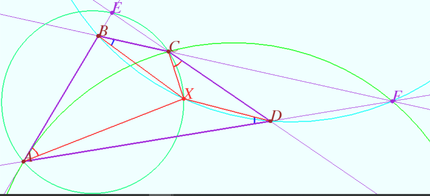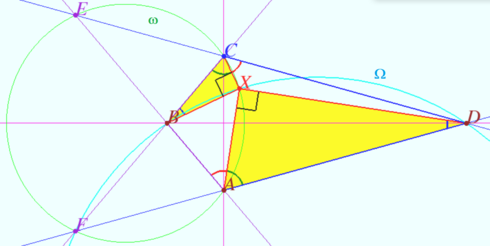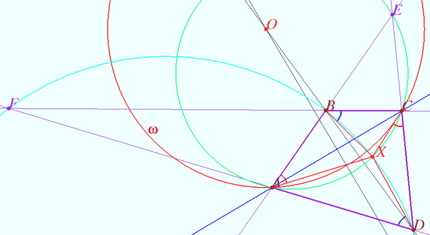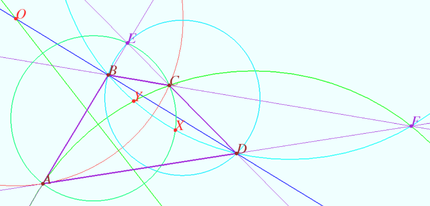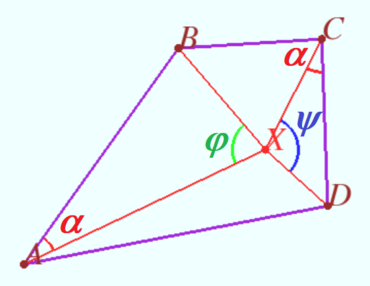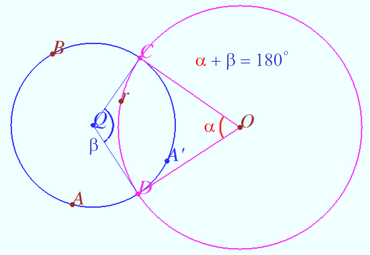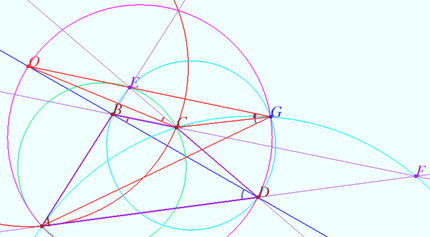Difference between revisions of "2018 IMO Problems/Problem 6"
(→Solution) |
(→Solution) |
||
| Line 10: | Line 10: | ||
The poinx <math>X</math> is inside <math>ABCD,</math> so points <math>E,A,X,C</math> follow in this order. | The poinx <math>X</math> is inside <math>ABCD,</math> so points <math>E,A,X,C</math> follow in this order. | ||
| − | <math>\angle XAB = \angle XCD \implies \angle XAE + | + | <math>\angle XAB = \angle XCD \implies \angle XAE + \angle XCE = 180^\circ \implies AXCE</math> is cyclic <math>\implies X</math> lie on circle <math>ACE.</math> |
<i><b>Special case</b></i> | <i><b>Special case</b></i> | ||
| − | Let < | + | Let <math>AD = CD</math> and <math>AB = BC \implies AB \cdot CD = BC \cdot DA.</math> |
| − | Let < | + | Let <math>E</math> and <math>F</math> be the intersection points of <math>AB</math> and <math>CD,</math> and <math>BC</math> and <math>DA,</math> respectively. |
| − | The points < | + | The points <math>B</math> and <math>D</math> are symmetric with respect to the circle <math>\omega = ACEF</math> <i><b>(Claim 1).</b></i> |
| − | The circle < | + | The circle <math>\Omega = FBD</math> is orthogonal to the circle <math>\omega</math> <i><b>(Claim 2).</b></i> |
| − | Let < | + | Let <math>X_0</math> be the point of intersection of the circles <math>\omega</math> and <math>\Omega.</math> |
| − | Quadrilateral < | + | Quadrilateral <math>AX_0CF</math> is cyclic <math>\implies</math> <cmath>\angle X_0AB = \frac {\overset{\Large\frown} {X_0CE}}{2} = \frac {360^\circ -\overset{\Large\frown} {X_0AFE}}{2} = 180^\circ - \angle X_0CE = \angle X_0CD.</cmath> |
| − | Similarly, quadrangle < | + | Similarly, quadrangle <math>DX_0BF</math> is cyclic <math>\implies \angle X_0BC = \angle X_0DA</math>. This means that point <math>X_0</math> coincides with the point <math>X</math>. |
| − | < | + | <math>\hspace{10mm} \angle FCX = \angle BCX = \frac {\overset{\Large\frown} {XAF}}{2}</math> of <math>\omega.</math> <math>\hspace{10mm} \angle CBX = \angle XDA = \frac {\overset{\Large\frown} {XBF}}{2}</math> of <math>\Omega.</math> |
| − | The sum < | + | The sum <math>\overset{\Large\frown} {XAF} + \overset{\Large\frown} {XBF} = 180^\circ</math> <i><b>(Claim 3)</b></i> <math>\implies</math> |
| − | < | + | <math>\angle XCB + \angle XBC = 90^\circ \implies \angle CXB = 90^\circ.</math> |
| − | Similarly, < | + | Similarly, <math>\angle AXD = 90^\circ \implies \angle BXA + \angle DXC = 360^\circ -\angle AXD -\angle CXB = 180^\circ.</math> |
[[File:2018 IMO 6e.png|430px|right]] | [[File:2018 IMO 6e.png|430px|right]] | ||
| Line 41: | Line 41: | ||
<i><b>Common case </b></i> | <i><b>Common case </b></i> | ||
| − | Denote by < | + | Denote by <math>O</math> the intersection point of <math>BD</math> and the perpendicular bisector of <math>AC.</math> Let <math>\omega</math> be a circle (red) with center <math>O</math> and radius <math>OA.</math> |
| − | The points < | + | The points <math>B</math> and <math>D</math> are symmetric with respect to the circle <math>\omega</math> <i><b>(Claim 1).</b></i> |
| − | The circles < | + | The circles <math>BDF</math> and <math>BDE</math> are orthogonal to the circle <math>\omega</math> <i><b>(Claim 2).</b></i> |
| − | Circles < | + | Circles <math>ACF</math> and <math>ACE</math> are symmetric with respect to the circle <math>\omega</math> <i><b>(Lemma).</b></i> |
| − | Denote by < | + | Denote by <math>X_0</math> the point of intersection of the circles <math>BDF</math> and <math>ACE.</math> |
| − | Quadrangle < | + | Quadrangle <math>BX_0DF</math> is cyclic <math>\implies \angle X_0BC = \angle X_0DA</math> (see Special case). |
| − | Similarly, quadrangle < | + | Similarly, quadrangle <math>AX_0CE</math> is cyclic <math>\implies \angle X_0AB = \angle X_0CD.</math> |
| − | This means that point < | + | This means that point <math>X_0</math> coincides with the point <math>X</math>. |
| − | Denote by < | + | Denote by <math>Y</math> the point of intersection of circles <math>BDF</math> and <math>ACF.</math> |
| − | Quadrangle < | + | Quadrangle <math>BYDF</math> is cyclic <math>\implies \angle CBY = \angle ADY.</math> |
| − | Quadrangle < | + | Quadrangle <math>AYCF</math> is cyclic <math>\implies \angle YAD = \angle BCY.</math> |
| − | The triangles < | + | The triangles <math>\triangle YAD \sim \triangle YCB</math> by two angles, so <cmath>\frac {BC}{AD} = \frac {CY}{AY} = \frac {BY} {DY} \hspace{10mm} (1).</cmath> |
| − | The points < | + | The points <math>X</math> and <math>Y</math> are symmetric with respect to the circle <math>\omega</math>, since they lie on the intersection of the circles <math>ACF</math> and <math>ACE</math> symmetric with respect to <math>\omega</math> and the circle <math>BDF</math> orthogonal to <math>\omega.</math> |
| − | The point < | + | The point <math>C</math> is symmetric to itself, the point <math>X</math> is symmetric to <math>Y</math> with respect to <math>\omega \implies \frac{CX}{CY} = \frac {R^2}{OC \cdot OY} , \frac {AX}{AY} = \frac {R^2}{OA \cdot OY}.</math> |
| − | Usung < | + | Usung <math>(1)</math> and the equality <math>OA = OC,</math> we get <cmath>\frac{CY}{AY} = \frac {CX}{AX} = \frac{BC}{AD}.</cmath> |
| − | The point < | + | The point <math>C</math> is symmetric to itself, the point <math>B</math> is symmetric to <math>D</math> with respect to <math>\omega \implies</math> |
<cmath>\triangle OBC \sim \triangle OCD \implies \frac {OB}{OC} = \frac {BC}{CD} = \frac {OC}{OD},</cmath> | <cmath>\triangle OBC \sim \triangle OCD \implies \frac {OB}{OC} = \frac {BC}{CD} = \frac {OC}{OD},</cmath> | ||
<cmath>\frac {OB}{OD} = \frac {OB}{OC} \cdot \frac {OC}{OD} = \frac{BC^2}{CD^2} = \frac{BC}{CD} \cdot \frac {AB}{AD}.</cmath> | <cmath>\frac {OB}{OD} = \frac {OB}{OC} \cdot \frac {OC}{OD} = \frac{BC^2}{CD^2} = \frac{BC}{CD} \cdot \frac {AB}{AD}.</cmath> | ||
| − | The point < | + | The point <math>B</math> is symmetric to <math>D</math> and the point <math>X</math> is symmetric to <math>Y</math> with respect to <math>\omega,</math> hence |
<cmath>\frac {BX}{DY} = \frac {R^2}{OD \cdot OY} ,\frac {DX}{BY} = \frac{R^2}{OB \cdot OY}.</cmath> | <cmath>\frac {BX}{DY} = \frac {R^2}{OD \cdot OY} ,\frac {DX}{BY} = \frac{R^2}{OB \cdot OY}.</cmath> | ||
<cmath>\frac{BX}{DX} =\frac{DY}{BY} \cdot \frac {OB}{OD} = \frac{AD}{BC} \cdot \frac{BC}{CD} \cdot \frac{AB}{AD} = \frac{AB}{CD}.</cmath> | <cmath>\frac{BX}{DX} =\frac{DY}{BY} \cdot \frac {OB}{OD} = \frac{AD}{BC} \cdot \frac{BC}{CD} \cdot \frac{AB}{AD} = \frac{AB}{CD}.</cmath> | ||
| Line 77: | Line 77: | ||
[[File:2018 IMO 6a.png|430px|right]] | [[File:2018 IMO 6a.png|430px|right]] | ||
| − | Denote < | + | Denote <math>\angle XAB = \angle XCD = \alpha, \angle BXA = \varphi, \angle DXC = \psi.</math> |
| − | By the law of sines for < | + | By the law of sines for <math>\triangle ABX,</math> we obtain <math>\frac {AB}{\sin \varphi} = \frac{BX}{\sin \alpha}.</math> |
| − | By the law of sines for < | + | By the law of sines for <math>\triangle CDX,</math> we obtain <math>\frac {CD}{\sin \psi} = \frac {DX}{\sin \alpha}.</math> |
| − | Hence we get < | + | Hence we get <math>\frac{\sin \psi} {\sin \varphi}= \frac {CD}{DX} \cdot \frac{BX}{AB} = 1.</math> |
| − | If < | + | If <math>\varphi = \psi,</math> then <math>\triangle XAB \sim \triangle XCD \implies \frac {CD}{AB} = \frac {BX}{DX} = \frac{AX}{CX} = \frac {AD}{BC}.</math> |
| − | < | + | <math>CD \cdot BC = AB \cdot AD \implies AD = CD, AB = BC.</math> This is a special case. |
| − | In all other cases, the equality of the sines follows < | + | In all other cases, the equality of the sines follows <math>\psi = 180° – \varphi \implies \varphi + \psi = 180°.</math> |
| − | <i><b>Claim 1</b></i> Let < | + | <i><b>Claim 1</b></i> Let <math>A, C,</math> and <math>E</math> be arbitrary points on a circle <math>\omega, l</math> be the perpendicular bisector to the segment <math>AC.</math> Then the straight lines <math>AE</math> and <math>CE</math> intersect <math>l</math> at the points <math>B</math> and <math>D,</math> symmetric with respect to <math>\omega.</math> |
| − | <i><b>Claim 2</b></i> Let points < | + | <i><b>Claim 2</b></i> Let points <math>B</math> and <math>D</math> be symmetric with respect to the circle <math>\omega.</math> Then any circle <math>\Omega</math> passing through these points is orthogonal to <math>\omega.</math> |
| − | <i><b>Claim 3</b></i> The sum of the arcs between the points of intersection of two perpendicular circles is < | + | <i><b>Claim 3</b></i> The sum of the arcs between the points of intersection of two perpendicular circles is <math>180^\circ.</math> |
| − | In the figure they are a blue and red arcs < | + | In the figure they are a blue and red arcs <math>\overset{\Large\frown} {CD}, \alpha + \beta = 180^\circ.</math> |
| − | <i><b>Lemma</b></i> The opposite sides of the quadrilateral < | + | <i><b>Lemma</b></i> The opposite sides of the quadrilateral <math>ABCD</math> intersect at points <math>E</math> and <math>F</math> (<math>E</math> lies on <math>AB</math>). The circle <math>\omega</math> centered at the point <math>O</math> contains the ends of the diagonal <math>AC.</math> The points <math>B</math> and <math>D</math> are symmetric with respect to the circle <math>\omega</math> (in other words, the inversion with respect to <math>\omega</math> maps <math>B</math> into <math>D).</math> Then the circles <math>ACE</math> and <math>ACF</math> are symmetric with respect to <math>\omega.</math> |
| − | <i><b>Proof</b></i> We will prove that the point < | + | <i><b>Proof</b></i> We will prove that the point <math>G,</math> symmetric to the point <math>E</math> with respect to <math>\omega,</math> belongs to the circle <math>ACF.</math> For this, we will prove the equality <math>\angle AGC = \angle AFC.</math> |
| − | A circle < | + | A circle <math>BDE</math> containing points <math>B</math> and <math>D</math> symmetric with respect to <math>\omega,</math> is orthogonal to <math>\omega</math> (Claim 2) and maps into itself under inversion with respect to the circle <math>\omega.</math> Hence, the point <math>E</math> under this inversion passes to some point <math>G,</math> of the same circle <math>BDE.</math> |
| − | A straight line < | + | A straight line <math>ABE</math> containing the point <math>A</math> of the circle <math>\omega,</math> under inversion with respect to <math>\omega,</math> maps into the circle <math>OADG.</math> Hence, the inscribed angles of this circle are equal <math>\angle ADB = \angle AGE.</math> |
| − | < | + | <math>\angle OCE = \angle CGE (CE</math> maps into <math>CG)</math> and <math>\angle OCE = \angle BCD (BC</math> maps into <math>DC).</math> |
| − | Consequently, the angles < | + | Consequently, the angles <math>\angle AFC = \angle ADB – \angle FBD = \angle AGE - \angle CGE = \angle AGC.</math> |
| − | These angles subtend the < | + | These angles subtend the <math>\overset{\Large\frown} {AC}</math> of the <math>ACF</math> circle, that is, the point <math>G,</math> symmetric to the point <math>E</math> with respect to <math>\omega,</math> belongs to the circle <math>ACF.</math> |
'''vladimir.shelomovskii@gmail.com, vvsss''' | '''vladimir.shelomovskii@gmail.com, vvsss''' | ||
Revision as of 06:00, 23 August 2022
A convex quadrilateral ![]() satisfies
satisfies ![]() Point
Point ![]() lies inside
lies inside
![]() so that
so that
![]() and
and ![]() Prove that
Prove that ![]()
Solution
We want to find the point ![]() Let
Let ![]() and
and ![]() be the intersection points of
be the intersection points of ![]() and
and ![]() and
and ![]() and
and ![]() respectively.
The poinx
respectively.
The poinx ![]() is inside
is inside ![]() so points
so points ![]() follow in this order.
follow in this order.
![]() is cyclic
is cyclic ![]() lie on circle
lie on circle ![]()
Special case
Let ![]() and
and ![]()
Let ![]() and
and ![]() be the intersection points of
be the intersection points of ![]() and
and ![]() and
and ![]() and
and ![]() respectively.
respectively.
The points ![]() and
and ![]() are symmetric with respect to the circle
are symmetric with respect to the circle ![]() (Claim 1).
(Claim 1).
The circle ![]() is orthogonal to the circle
is orthogonal to the circle ![]() (Claim 2).
(Claim 2).
Let ![]() be the point of intersection of the circles
be the point of intersection of the circles ![]() and
and ![]() Quadrilateral
Quadrilateral ![]() is cyclic
is cyclic ![]()
![]()
Similarly, quadrangle ![]() is cyclic
is cyclic ![]() . This means that point
. This means that point ![]() coincides with the point
coincides with the point ![]() .
.
![]() of
of ![]()
![]() of
of ![]()
The sum ![]() (Claim 3)
(Claim 3) ![]()
![]()
Similarly, ![]()
Common case
Denote by ![]() the intersection point of
the intersection point of ![]() and the perpendicular bisector of
and the perpendicular bisector of ![]() Let
Let ![]() be a circle (red) with center
be a circle (red) with center ![]() and radius
and radius ![]()
The points ![]() and
and ![]() are symmetric with respect to the circle
are symmetric with respect to the circle ![]() (Claim 1).
(Claim 1).
The circles ![]() and
and ![]() are orthogonal to the circle
are orthogonal to the circle ![]() (Claim 2).
(Claim 2).
Circles ![]() and
and ![]() are symmetric with respect to the circle
are symmetric with respect to the circle ![]() (Lemma).
(Lemma).
Denote by ![]() the point of intersection of the circles
the point of intersection of the circles ![]() and
and ![]() Quadrangle
Quadrangle ![]() is cyclic
is cyclic ![]() (see Special case).
Similarly, quadrangle
(see Special case).
Similarly, quadrangle ![]() is cyclic
is cyclic ![]()
This means that point ![]() coincides with the point
coincides with the point ![]() .
.
Denote by ![]() the point of intersection of circles
the point of intersection of circles ![]() and
and ![]()
Quadrangle ![]() is cyclic
is cyclic ![]()
Quadrangle ![]() is cyclic
is cyclic ![]()
The triangles ![]() by two angles, so
by two angles, so ![]()
The points ![]() and
and ![]() are symmetric with respect to the circle
are symmetric with respect to the circle ![]() , since they lie on the intersection of the circles
, since they lie on the intersection of the circles ![]() and
and ![]() symmetric with respect to
symmetric with respect to ![]() and the circle
and the circle ![]() orthogonal to
orthogonal to ![]()
The point ![]() is symmetric to itself, the point
is symmetric to itself, the point ![]() is symmetric to
is symmetric to ![]() with respect to
with respect to ![]() Usung
Usung ![]() and the equality
and the equality ![]() we get
we get ![]() The point
The point ![]() is symmetric to itself, the point
is symmetric to itself, the point ![]() is symmetric to
is symmetric to ![]() with respect to
with respect to ![]()
![]()
![]() The point
The point ![]() is symmetric to
is symmetric to ![]() and the point
and the point ![]() is symmetric to
is symmetric to ![]() with respect to
with respect to ![]() hence
hence
![]()
![]()
Denote ![]()
By the law of sines for ![]() we obtain
we obtain ![]()
By the law of sines for ![]() we obtain
we obtain ![]()
Hence we get ![]()
If ![]() then
then ![]()
![]() This is a special case.
This is a special case.
In all other cases, the equality of the sines follows ![]()
Claim 1 Let ![]() and
and ![]() be arbitrary points on a circle
be arbitrary points on a circle ![]() be the perpendicular bisector to the segment
be the perpendicular bisector to the segment ![]() Then the straight lines
Then the straight lines ![]() and
and ![]() intersect
intersect ![]() at the points
at the points ![]() and
and ![]() symmetric with respect to
symmetric with respect to ![]()
Claim 2 Let points ![]() and
and ![]() be symmetric with respect to the circle
be symmetric with respect to the circle ![]() Then any circle
Then any circle ![]() passing through these points is orthogonal to
passing through these points is orthogonal to ![]()
Claim 3 The sum of the arcs between the points of intersection of two perpendicular circles is ![]() In the figure they are a blue and red arcs
In the figure they are a blue and red arcs ![]()
Lemma The opposite sides of the quadrilateral ![]() intersect at points
intersect at points ![]() and
and ![]() (
(![]() lies on
lies on ![]() ). The circle
). The circle ![]() centered at the point
centered at the point ![]() contains the ends of the diagonal
contains the ends of the diagonal ![]() The points
The points ![]() and
and ![]() are symmetric with respect to the circle
are symmetric with respect to the circle ![]() (in other words, the inversion with respect to
(in other words, the inversion with respect to ![]() maps
maps ![]() into
into ![]() Then the circles
Then the circles ![]() and
and ![]() are symmetric with respect to
are symmetric with respect to ![]()
Proof We will prove that the point ![]() symmetric to the point
symmetric to the point ![]() with respect to
with respect to ![]() belongs to the circle
belongs to the circle ![]() For this, we will prove the equality
For this, we will prove the equality ![]()
A circle ![]() containing points
containing points ![]() and
and ![]() symmetric with respect to
symmetric with respect to ![]() is orthogonal to
is orthogonal to ![]() (Claim 2) and maps into itself under inversion with respect to the circle
(Claim 2) and maps into itself under inversion with respect to the circle ![]() Hence, the point
Hence, the point ![]() under this inversion passes to some point
under this inversion passes to some point ![]() of the same circle
of the same circle ![]()
A straight line ![]() containing the point
containing the point ![]() of the circle
of the circle ![]() under inversion with respect to
under inversion with respect to ![]() maps into the circle
maps into the circle ![]() Hence, the inscribed angles of this circle are equal
Hence, the inscribed angles of this circle are equal ![]()
![]() maps into
maps into ![]() and
and ![]() maps into
maps into ![]() Consequently, the angles
Consequently, the angles ![]() These angles subtend the
These angles subtend the ![]() of the
of the ![]() circle, that is, the point
circle, that is, the point ![]() symmetric to the point
symmetric to the point ![]() with respect to
with respect to ![]() belongs to the circle
belongs to the circle ![]()
vladimir.shelomovskii@gmail.com, vvsss





